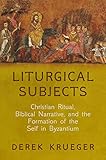Liturgical Subjects : Christian Ritual, Biblical Narrative, and the Formation of the Self in Byzantium / Derek Krueger.
Material type: TextSeries: Divinations: Rereading Late Ancient ReligionPublisher: Philadelphia : University of Pennsylvania Press, [2014]Copyright date: ©2015Description: 1 online resource (328 p.) : 24 illusContent type:
TextSeries: Divinations: Rereading Late Ancient ReligionPublisher: Philadelphia : University of Pennsylvania Press, [2014]Copyright date: ©2015Description: 1 online resource (328 p.) : 24 illusContent type: - 9780812246445
- 9780812290158
- 264/.0140956
- BX350
- online - DeGruyter
- Issued also in print.
| Item type | Current library | Call number | URL | Status | Notes | Barcode | |
|---|---|---|---|---|---|---|---|
 eBook
eBook
|
Biblioteca "Angelicum" Pont. Univ. S.Tommaso d'Aquino Nuvola online | online - DeGruyter (Browse shelf(Opens below)) | Online access | Not for loan (Accesso limitato) | Accesso per gli utenti autorizzati / Access for authorized users | (dgr)9780812290158 |
Browsing Biblioteca "Angelicum" Pont. Univ. S.Tommaso d'Aquino shelves, Shelving location: Nuvola online Close shelf browser (Hides shelf browser)

|

|

|

|

|

|

|
||
| online - DeGruyter Practicing Piety in Medieval Ashkenaz : Men, Women, and Everyday Religious Observance / | online - DeGruyter Adapting to Win : How Insurgents Fight and Defeat Foreign States in War / | online - DeGruyter The Altar at Home : Sentimental Literature and Nineteenth-Century American Religion / | online - DeGruyter Liturgical Subjects : Christian Ritual, Biblical Narrative, and the Formation of the Self in Byzantium / | online - DeGruyter Unraveling Somalia : Race, Class, and the Legacy of Slavery / | online - DeGruyter Race and the Cherokee Nation : Sovereignty in the Nineteenth Century / | online - DeGruyter The Opened Letter : Networking in the Early Modern British World / |
Frontmatter -- Contents -- Abbreviations and a Note on Texts -- Chapter 1. Shaping Liturgical Selves -- Chapter 2. Romanos the Melodist and the Christian Self -- Chapter 3. Calendar and Community in the Sixth Century -- Chapter 4. Eucharistic Prayers: Compunction and the History of Salvation -- Chapter 5. The Penitential Bible and the Great Kanon of Andrew of Crete -- Chapter 6. The Voice of the Sinner in First-Person Hymns of the Lenten Triodion -- Chapter 7. Liturgies of the Monastic Self in Symeon the New Theologian -- Conclusion.A Communion of Savable Sinners -- Notes -- Bibliography -- Index of Biblical Citations -- General Index -- Acknowledgments
restricted access online access with authorization star
http://purl.org/coar/access_right/c_16ec
Liturgical Subjects examines the history of the self in the Byzantine Empire, challenging narratives of Christian subjectivity that focus only on classical antiquity and the Western Middle Ages. As Derek Krueger demonstrates, Orthodox Christian interior life was profoundly shaped by patterns of worship introduced and disseminated by Byzantine clergy. Hymns, prayers, and sermons transmitted complex emotional responses to biblical stories, particularly during Lent. Religious services and religious art taught congregants who they were in relation to God and each other.Focusing on Christian practice in Constantinople from the sixth to eleventh centuries, Krueger charts the impact of the liturgical calendar, the eucharistic rite, hymns for vigils and festivals, and scenes from the life of Christ on the making of Christian selves. Exploring the verse of great Byzantine liturgical poets, including Romanos the Melodist, Andrew of Crete, Theodore the Stoudite, and Symeon the New Theologian, he demonstrates how their compositions offered templates for Christian self-regard and self-criticism, defining the Christian "I." Cantors, choirs, and congregations sang in the first person singular expressing guilt and repentence, while prayers and sermons defined the collective identity of the Christian community as sinners in need of salvation. By examining the way models of selfhood were formed, performed, and transmitted in the Byzantine Empire, Liturgical Subjects adds a vital dimension to the history of the self in Western culture.
Issued also in print.
Mode of access: Internet via World Wide Web.
In English.
Description based on online resource; title from PDF title page (publisher's Web site, viewed 30. Aug 2021)


